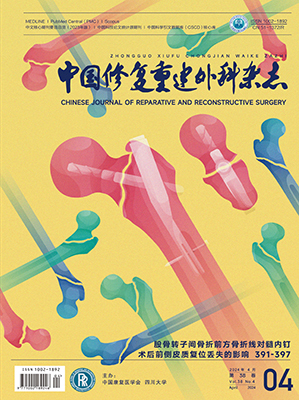| 1. |
Wang JC, Guo Q, Li B. Tendon biomechanics and mechano-biology-a minireview of basic concepts and recent advancements. J Hand Ther, 2012, 25(2):133-141.
|
| 2. |
Woo SL, Debski RE, Zeminski J, et al. Injury and repair of ligaments and tendons. Annu Rev Biomed Eng, 2000, 2:83-118.
|
| 3. |
Salingcarnboriboon R, Yoshitake H, Tsuji K, et al. Establishment of tendon-derived cell lines exhibiting pluripotent mesenchymal stem cell-like property. Exp Cell Res, 2003, 287(2):289-300.
|
| 4. |
Bi Y, Ehirchiou D, Kilts TM, et al. Identification of tendon stem/progenitor cells and the role of the extracellular matrix in their niche. Nat Med, 2007, 13(10):1219-1227.
|
| 5. |
Yin Z, Chen X, Chen JL, et al. The regulation of tendon stem cell differentiation by the alignment of nanofibers. Biomaterials, 2010, 31(8):2163-2175.
|
| 6. |
Rui YF, Lui PP, Li G, et al. Isolation and characterization of muhipotent rat tendon-derived stem cells. Tissue Eng Part A, 2010, 16(5):1549-1558.
|
| 7. |
Zhang J, Wang JH. Mechanobiological response of tendon stem cells:implications of tendon homeostasis and pathogenesis of tendinopathy. J Orthop Res, 2010, 28(5):639-643.
|
| 8. |
Zhang J, Wang JH. Production of PGE(2) increases in tendons subjected to repetitive mechanical loading and induces differentiation of tendon stem cells into non-tenocytes. J Orthop Res, 2010, 28(2):198-203.
|
| 9. |
邓银栓, 唐康来, 谢美明, 等. 不同牵伸载荷对体外培养人肌腱细胞纤维型肌动蛋白的影响. 中华医学杂志, 2011, 91(25):1780-1785.
|
| 10. |
胡超, 唐康来, 陈万, 等. 大鼠跟腱来源肌腱干细胞的分离培养及鉴定. 第三军医大学学报, 2013, 35(11):1097-1101.
|
| 11. |
Sonowal H, Kumar A, Bhattacharyya J, et al. Inhibition of actin polymerization decreases osteogeneic differentiation of mesenchymal stem cells through p38 MAPK pathway. J Biomed Sci, 2013, 20:71.
|
| 12. |
Zeng LH, Xu L, Rensing NR, et al. Kainate seizures cause acute dendritic injury and actin depolymerization in vivo. J Neurosci, 2007, 27(43):11604-11613.
|
| 13. |
Kustermans G, El Benna J, Piette J, et al. Perturbation of actin dynamics induces NF-kappaB activation in myelomonocytic cells through an NADPH oxidase-dependent pathway. Biochem J, 2005, 387(Pt2):531-540.
|
| 14. |
Genescà M, Sola A, Hotter G, et al. Actin cytoskeleton derangement induces apoptosis in renal ischemia/reperfusion. Apoptosis, 2006, 11(4):563-571.
|
| 15. |
Bugyi B, Carlier MF. Control of actin filament treadmilling in cell motility. Annu Rev Biophys, 2010, 39:449-470.
|
| 16. |
Pollard TD, Blanchoin L, Mullins RD. Molecular mechanisms controlling actin filament dynamics in nonmuscle cells. Annu Rev Biophys Biomol Struct, 2000, 29:545-576.
|
| 17. |
Schwartz MA, DeSimone DW. Cell adhesion receptors in mechanotransduction. Curr Opin Cell Biol, 2008, 20(5):551-556.
|
| 18. |
Schwartz MA. Integrins and extracellular matrix in mechanotransduction. Cold Spring Harb Perspect Biol, 2010, 2(12):a005066.
|
| 19. |
Vogel V, Sheetz MP. Cell fate regulation by coupling mechanical cycles to biochemical signaling pathways. Curr Opin Cell Biol, 2009, 21(1):38-46.
|
| 20. |
Titushkin I, Cho M. Modulation of cellular mechanics during osteogenic differentiation of human mesenchymal stem cells. Biophys J, 2007, 93(10):3693-3702.
|
| 21. |
Erickson GR, Gimble JM, Franklin DM, et al. Chondrogenic potential of adipose tissue-derived stromal cells in vitro and in vivo. Biochem Biophys Res Commun, 2002, 290(2):763-769.
|
| 22. |
McBeath R, Pirone DM, Nelson CM, et al. Cell shape, cytoskeletal tension, and RhoA regulate stem cell lineage commitment. Dev Cell, 2004, 6(4):483-495.
|
| 23. |
Himangshu Sonowal, Atul Kumar, Jina Bhattacharyya, et al. Inhibition of actin polymerization decreases osteogeneic differentiation of mesenchymal stem cells through p38 MAPK pathway. Journal of Biomedical Science, 2013, 20:71.
|
| 24. |
马林, 唐康来, 周兵华, 等. 机械牵伸对体外大鼠肌腱干细胞RhoA/Rho相关蛋白激酶分子表达的影响. 中国修复重建外科杂志, 2014, 28(5):639-643.
|
| 25. |
Teramura T, Takehara T, Onodera Y, et al. Mechanical stimulation of cyclic tensile induces reduction of pluripotent related gene expressions via activation of RhoA/ROCK and subsequent decreasing of AKT phosphorylation in human indiced pluripotent stem cells. Biochem Biophys Res Commun, 2012, 417(2):836-841.
|




